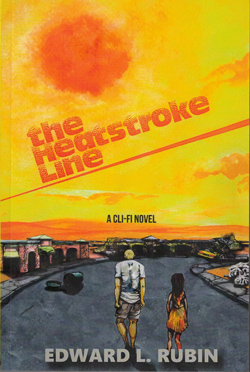The Heatstroke Line by Edward L. Rubin; Sunbury Press © 2015; ISBN 978-1-62006-626-3; 233 pages; $14.95
By Donald H. Harrison

 SAN DIEGO – Our correspondent in Taiwan, Dan Bloom, who is a cli-fi enthusiast, has already written about this book, but when a copy came my way, I thought I’d check it out as well. Author Rubin, a member of our Jewish community, is a professor of law and political science at Vanderbilt University in Nashville, and he integrates some of the theories of political science into this interesting novel.
SAN DIEGO – Our correspondent in Taiwan, Dan Bloom, who is a cli-fi enthusiast, has already written about this book, but when a copy came my way, I thought I’d check it out as well. Author Rubin, a member of our Jewish community, is a professor of law and political science at Vanderbilt University in Nashville, and he integrates some of the theories of political science into this interesting novel.
The setting is pure climate fiction (or cli-fi): Rising temperatures have melted the ice caps, causing sea levels to rise and residents of coastal cities to become refugees. In the interior of the United States, below the “heatstroke line” it became so hot as to be unbearable. In the scramble for habitable land and for resources, a war broke out between the U.S. and Canada, its climatically temperate northern neighbor. Although the United States dropped nuclear bombs on Toronto and Montreal, Canada nevertheless prevailed in the conflict. To punish the U.S., and to make its former ice-covered lands more habitable, Canada used huge machines to scrape the topsoil off a huge swath of the United States, leaving it barren. This area became nicknamed the Enamel, or NML, for No-Man’s Land. But it was hospitable to a new, deadly type of beetle, called a “Biter Bug.” Large, and having a voracious appetites, they flew onto the faces, arms, legs and torsos of hapless human beings who wandered into their territory, and consumed them chunk by chunk. Inhabited sections of the country feared the biter bugs might migrate towards them.
In the wake of the great war, the United States became what might be called the “Untied” States, that is it broke apart, so that instead of one coast-to-coast country, there were various regional authorities, such as in Mountain America, with Denver, Colorado, as its capital, and there were also small confederacies, similar to old fashioned city states, in particular along the Gulf of Mexico. Although various patriots called for the reunification of the United States, the small nation states had no trust for each other. Furthermore, each of these post-war entities were riven with internal political dissent.
It was remarkably similar to the world described in classical political theory by philosopher Thomas Hobbes, who posited that governments became necessary early in man’s history in order to stave off the incessant fighting in proto-societies in which everyone murderously was against everyone else.
And if a classic definition holds of politics being a system for the allocation of scarce resources, in this post-war America almost everything needed to be closely rationed—land, food, water—making life for some a struggle for basic resources, while others, especially those in government, enjoyed relative plenty.
The plot of this book concerns Daniel Danten, an entomologist living in Mountain America, whose interest in combating biter bugs brings him to the attention not only of his own government, but of those of Canada and one of the Confederacies. While on a diplomatic mission, his companion is brutally subjected to biter bug torture, and Dan is forced to conduct his research for an enemy government. It is imperative that he find a way home to his family, but Dan cannot help feeling an intellectual attachment to the older daughter of the family who keeps him captive.
So…. climate, politics, suspense, and even some literary discussions pack this novel. As hard as it is to imagine the dismemberment of America, The Heatstroke Line is a fascinating read.
Below is a commentary by author Rubin concerning the circumstances leading up to his writing this novel.
*
Harrison is editor of San Diego Jewish World. He may be contacted via donald.harrison@sdjewishworld.com
***
By Edward L. Rubin
NASHVILLE, Tennessee — I wrote ‘The Heatstroke Line out of a sense of frustration. I’ve spent most of my professional life studying government, and so I’ve dealt with what it can do right and how it can go wrong. I think the current failure to deal seriously with climate change is one of the worst governmental failures I’ve experienced in my lifetime. It is hard for me to believe that responsible government leaders wouldn’t take the issue seriously, given the extent of the threat.
The immediate motivation to write the book came from a conversation with a colleague, someone who specializes in environmental law and felt the same sense of frustration that I did. It occurred to me that the reason people allow our government leaders to ignore such a severe threat is that its consequences are abstract. The short term effects of climate changes are likely to occur in less developed nations that have tropical climates, weaker health care systems, and less adequate food supplies. It will be a fairly long time before there are major disruptions in the U.S., but those disruptions will inevitably arrive unless we take action.
No one can predict exactly what form the disruptions caused by climate change will take. The scenario presented in the book is not implausible, however. Scientists who study this issue are almost all agreed that sea levels will rise. I based the extent of the rise depicted in the novel on a well-researched website, www.climatecentral.org Seven of our ten largest metropolitan areas lie along the coast, at sea level — New York, Los Angeles, Houston, Philadelphia, Washington DC, Miami and Boston. Only LA has any high ground to which its citizens can retreat. If the other cities (and many smaller coastal cities) flood repeatedly due to storm surges, their residents will be refugees, seeking shelter in other parts of the country. Our political system is resilient, but will it really be able to endure a stress of that magnitude? My guess, as depicted in the novel, is that it won’t.
The Heatstroke Line belongs to a genre called “cli-fi” a term developed by Dan Bloom, who runs a blog about it and has been an important supporter of my efforts. There are already a number of novels, some of which can be classified as cli-fi, that depict the world, or the US, in the wake of disaster. But many of them use disaster — nuclear war, epidemic or ecological collapse — to dispense with the complexities of modern civilization and tell an adventure story. I do something different in The Heatstroke Line. The world it predicts is still a recognizable one, with cities, government and the annoying political conflicts that we presently experience. But our nation has lost its power and its prosperity as a result of the stresses caused by the deterioration of its climate.
This may not happen, but it is a real possibility. I can’t understand why we would want to take that chance. Many of the proposals to reduce carbon emissions are things that would make life better even if there were no climate change. People will save enormous amounts of time and stress if we build mass transit, they will save money if they can monitor their home energy consumption and drive more fuel-efficient cars, they will save even more money, and enjoy greater convenience, if we built “intelligent” homes with small or zero carbon footprints.
The Heatstroke Line is intended to alert people to do the danger we face and encourage them to think about solutions such as these. But I thought the most effective way to do this was to write an entertaining, readable novel, rather than one filled with long speeches and technical data. The characters took on a life of their own as I wrote it, and I hope the book works as literature as well as persuasion.
*
Rubin is a professor of law and political science at Vanderbilt University.
The author is free to make any predictions he cares to. However, outside of computer models promoted by the climate change enthusiasts, that have failed every attempt to make any accurate predictions, there is no hard evidence to support man made climate change. The satellite data also show no evidence of man made climate change.
Jerome C Liner, Cincinnati, OH